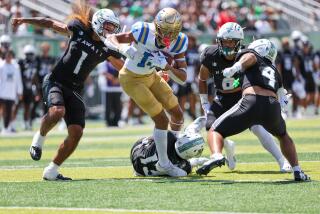Flight of Fancy
On Saturday afternoons, my mother practiced her golf swing in the backyard, my father gathering objects she could hit. When she ran out of pink and orange Wiffle balls, he’d gather avocado seeds from the foot of our tree, pulpy lemons from a neighbor’s yard and tennis balls broken in by the dog. With cash or a bottle of wine, he appeased the gardener who threatened to quit over a lawn slowly gouged to death by her divots. It didn’t bother my father that our garden wall and the back of the stucco house were pitted and muddied from her shots. What mattered was that he could provide her with something to hit. A charcoal briquette, a plastic Easter egg, a Ping-Pong ball.
For as long as I can remember, my father, an avid golfer, kept a shoe box full of golf balls in the kitchen, but they were to be used only “on the course.” I didn’t know what that meant, but it sounded important. Occasionally I’d slide my fingers over the balls in the box and try to decode the emblems and markings, imagining that each one held a secret power or message, but the balls remained cold and unresponsive. Though they were the whitest and shiniest of any balls I had seen, I could tell they lacked give. It irritated me that they didn’t bounce like the kickballs and basketballs I played with in the alley behind our house. I figured that a golf ball must be hard to the core--not my kind of ball.
I didn’t think much of golf balls until my father took us--my mother, younger sister, two older brothers and me--from our home in Long Beach to Rosarita Beach in Baja. I was about 8. After the long drive, we wanted to jump in the water but couldn’t. Thousands of bluish-white jellyfish swarmed the waters outside the hotel. We played on the beach anyway, wrapped up in towels to keep sand fleas from biting our hot skin.
My father tugged on a piece of broken fishing line that he had found snagged on a log. Hand over hand, he reeled in the line, giving an extra yank or two to keep it moving while we watched, curious as to what could be putting up such a struggle.
“You always wonder why it snapped,” he told us. “Could be kelp--or a very large fish?” Quite suddenly, accompanied by a jerk of his strong arm, my father stooped down and reached into the water, raising a mass of gray tangle. Slowly he worked his hands through until he found the fishhook, which protruded from a remnant of a golf ball’s dimpled, dingy cover to which thin elastic strings were still attached.
“A Top-Flite!” my father shouted to my mother, who was on the hotel patio.
“Ball guts,” my brothers screamed, joyfully, trying to stretch it farther apart.
“Where’s the golf course?” my mother wanted to know.
That same year, my father took me to the driving range to hit my first real golf ball. I prayed that it wouldn’t crack open and spill out like the brains of a monster in a horror movie. Each week that we’d return to the range, I’d watch my 6-foot-3 father, an ex-lifeguard, crush balls with a swing that caused me to flinch from its speed and power. Only once, however, did I actually see him split open a golf ball. He struck one that already had a “smile on its cover,” and it exploded into a mass of thread in mid-flight and fell to the ground much like a dud firecracker.
I never did get used to the idea that so much stuff could fit inside such a small ball. I pictured someone painstakingly wrapping miles of elastic string around a little rubber core, and the thought that anyone would pay so much attention to a ball baffled me.
Right about the time my mother bought me my first bikini--orange and white polka dots--I started hearing about a two-piece golf ball. “Tougher, flies higher,” my father said, raising his eyebrows. “We’ll see.” My brothers tried to smash one open with a baseball bat, but it was impossibly hard. One night my father brought home a ball that had a deep gouge, and we pried it open. It split into two solid white pieces. After all that effort, the ball in its new two-piece shape seemed boring.
It wasn’t until my father took me out on the golf course that I realized there was something to the ball. It was like magic whenever I hit it into the air; it was like a rock when I miss-hit it. Even as a 10-year-old, I began to discern that the difference between a shot that felt good and one that sent shock waves up my arms and spine came down to that minuscule moment of contact between club head and ball.
During junior golf, when I began competing in tournaments all over Southern California, my father sent me off with a plastic bag of assorted golf balls, some of which had been tested out during his Saturday rounds and some wayward balls that he’d pocketed on the driving range, but most were balls that he’d recovered from lakes or beds of ice plant or high rough. He delighted in giving an orphan ball a new life, redemption with a different golfer.
Before my tournaments, my father would carefully go over each ball, advising me to use the ones that would clean up like new for teeing off, and to save the “water balls”--named from where he’d rescued them--for holes with lakes and creeks. He identified which balls to use when the wind was up, and the ones that would roll best on the greens. Those were the days when we weren’t required to stick to one specific ball type--or we were ignorant of the rule. I took his advice and switched balls, often according to playing conditions, but mostly based on whim. If I started the round out well, chances were that I would keep upgrading my ball. But if my game turned rotten, I’d give equal time to the well-beaten balls, willing to give his logic a shot.
I never doubted my father’s belief in seasoned balls because on our hallway wall was a fancy hole-in-one oak plaque on which was mounted the actual ball and tee he used to accomplish his perfect golf shot. There was a huge, grinning gash across that ball’s cover.
It was also during junior golf that I first noticed that a ball could become a personalized, coveted thing. Well-behaved balls were whispered to, charmed with kisses, washed and polished, warmed in pockets and palms. Disobedient balls were cursed, tossed into lakes, stomped on, bounced into the street, abandoned in bushes or trashed.
I have watched many teenage competitors stick to one type of ball and identifying number, usually a No. 1, 2 or 3--corresponding to the maximum number of strokes ultimately hoped to make on each hole. I have seen golfers teeing up balls and lining putts so that the signature name is right side up or face down on the tee, or horizontal with the club face--they simply wouldn’t hit it any other way. Like my fellow golfers, I began to engrave my balls with signature or cryptic ink markings that served to identify, but also fortified, the superstition that a ball was less than whole without my personal branding.
A new ball radiated serious intent and a fresh start, but my father didn’t buy it. “You’ve got to go beneath the surface to get the whole banana,” he would say, reminding me that in the long run it’s not the cute dimples, the unblemished name or lack of lines and seams that sends the ball soaring. “Besides, used golf balls carry experience and tend to be more forgiving.”
This year my 15-year-old son--like most of his high school golf teammates--teed off with only new balls, which his golfer-father supplies him. I don’t know what happens to all those balls; some days I can go through his golf bag without finding a single seasoned ball. “Where do they go?” I’ve asked him. His usual response--a quizzical look--suggests that I’ve gone batty.
I’m not too worried. I know the day will come when my son will hand me balls for my collection, balls that have gone a round or two, or maybe some that he’s found in the rough or lake. I know this because whenever he and I play golf with my 73-year-old father, it’s only a matter of half a hole before they are both tromping together in the rough on a hunt for discarded balls.
Just the other day, out for an afternoon of nine holes, their hoots to each other, “I found another one,” bring my mother and me over to the bushes to look at their latest catch; a ProStaff No. 2 embellished with a profile of a Native American chief in headdress and long braid overseeing rows of corn and what appears to be a fort, and a Flying Lady No. 1 that bears a mermaid sitting on a rock. In one of her hands is a golf club, and at the bottom of her fishtail is stamped “Tina.”
“These are keepers,” my father says, bartering with me over ownership rights, wanting to hear just how much these old balls are worth to me. “You can have one if you help fix my slice.”






